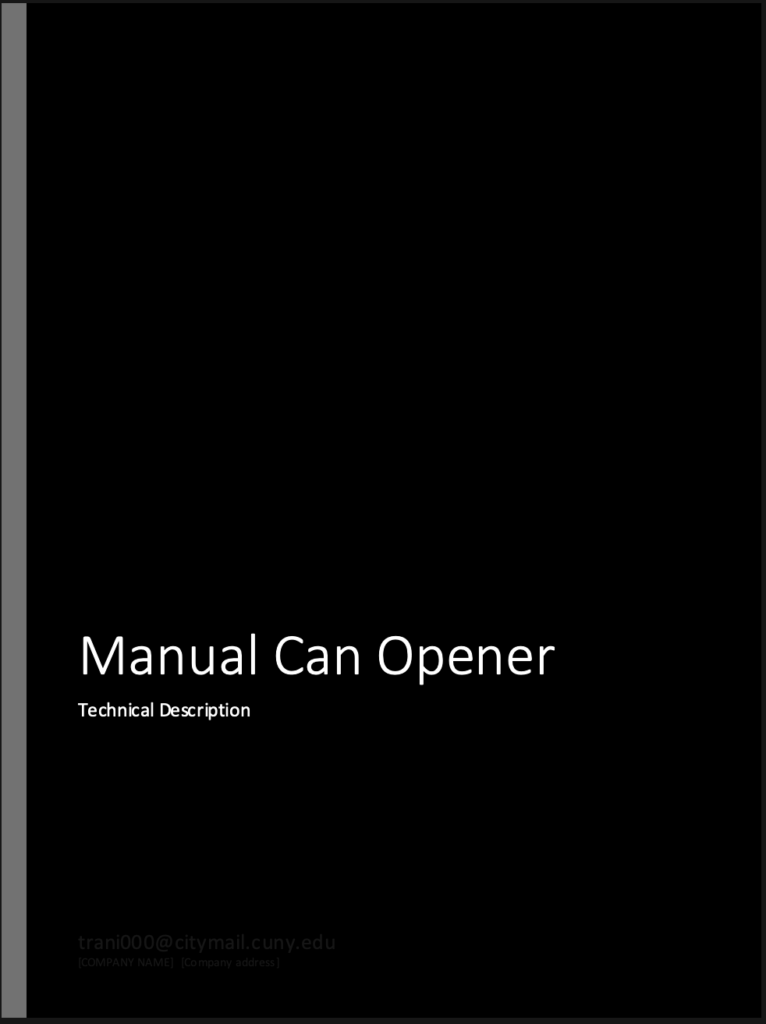
Table of Contents
Introduction 2
Components 2
How to Use 3
Conclusion 3
References 4
Tanha Rani
October 20th, 2021
Writing for Engineering Technical Description Draft
Technical Description for a Manual Can-Opener
Introduction:
A can-opener is a metal device used to open the top of tin cans when the knob is turned clockwise, while a sharp gear pierces the skin of the lid. The knob is turned until the whole top of the can is cut, and you can remove it completely. Can-openers come in many different sizes, but are typically 7 inches long, and 3 inches wide. The material they are usually made of are metal with the grips being rubber or silicone. They can typically weigh around 1lb and come in a variety of colors. There are handles for gripping, and various metal wheels on the top that work together to allow for the top of a can to be cut.
Components:
- Rubber Griped Handles: These handles located on the bottom of the device are used for a firm grip during its use.
- Cutting Wheel: Paired with the traction gear, the cutting wheel is a sharp edge that cuts through the metal of cans. The cutting wheel is forced on to the lid of the can causing the lid to be cut as the wheels are turned, allowing the can to be cut all around.
- Hand Crank/Turning Knob: Turned clockwise to activate the wheels as they slowly cut the top portion of the can.
- Upper Gear/Traction Gear: A small metal with a round shape that has notches all around. When the knob is turned, the traction gear allows for the wheels to latch onto the surface of the can for precise and even cuts.
- Bottle Opener: The bottle opener is located on the side of the can opener and able to latch on to the tops of glass bottle because of the sharp ends. After latching on, the tops can be removed by going in a swift upwards motion until the cap is off.
How To Use:
- Place the can-opener and the can(s) you would like to open on a levelled surface. Make sure your hands are clean and free of any slippery lubricants and observe the can opener to make sure it is clean and that all the components are correctly situated.
- Hold the can-opener by the rubber grips in your left hand with the wheels facing away from you and towards your can.
- Take the can and place it directly in front of you. Open the can-opener by using both hands in an outward motion while holding the grips.
- Place the can-opener on top of the can (while it is still open) making sure the can is in between the cutting wheel and lower gear. Press the two grips together with your left hand so the wheels can latch on to the can.
- Keeping the can on a leveled surface and your left hand firmly holding on to the grips, turn the turning knob with your right hand clockwise while your left hand is still gripping the handles.
- Turn the knob as it cuts all around the can.
- Remove the can-opener from the can and take off the metal lid that is now fully removed from the can.
- Wash and store your device in a clean area out of reach from children.
Conclusion:
The modern day can-opener was patented by Charles Arthur Bunker in 1931. Before this, many other versions of the design were being used until Bunker’s version was standardized. Can openers cost anywhere from 2-20 dollars depending on the quality and/or extra functions. They can be bought in convenient stores and appliance shopping sites like target.com. Although the manual can-opener is a must have in many households, it is slowly being replaced by electric can-openers that are quicker and require minimal effort.
References
Mitchell & Cooper. The History of the Can Opener.
https://www.mitchellcooper.co.uk/can-opener-history
Nayakanti, Nigamaa. Working of Can Opener.
https://nigamaanayakanti.weebly.com/can-opener.html
Xaxx, Jagg. (2017, July 21st) Mechanism Description of a Manual Can Opener. Sciencing.
https://sciencing.com/mechanism-description-of-a-manual-can-opener-12587926.html
Target. Manual Can Opener Black- Room Essentials.
https://www.target.com/p/manual-can-opener-black-room-essentials-8482/-/A-81246454


